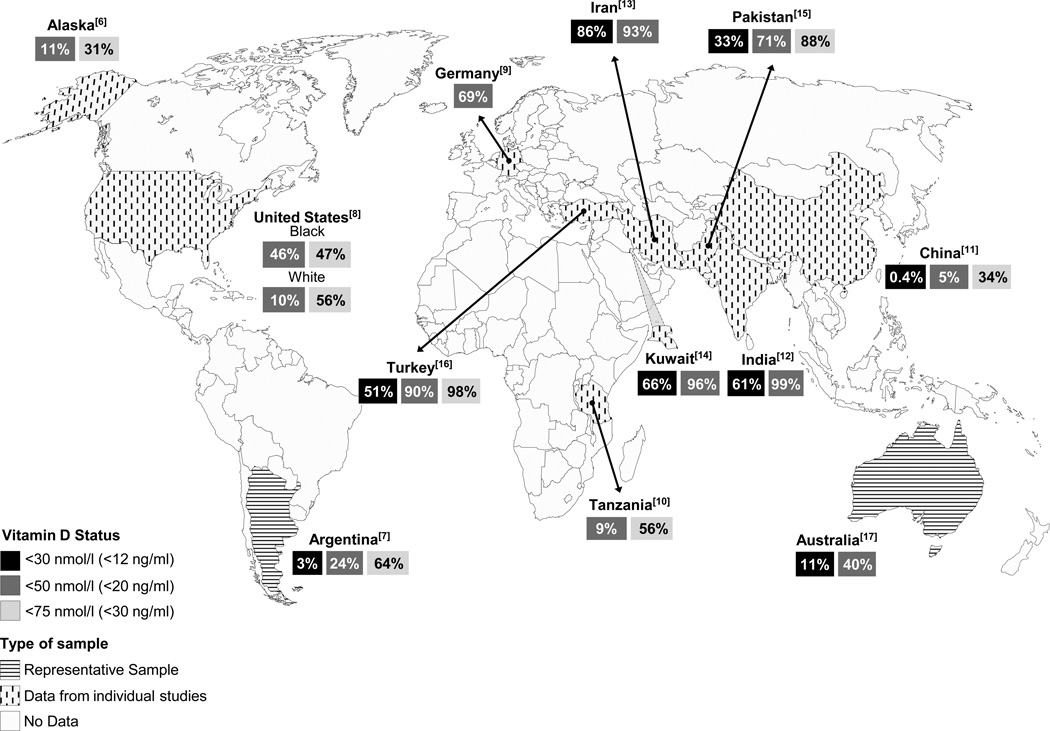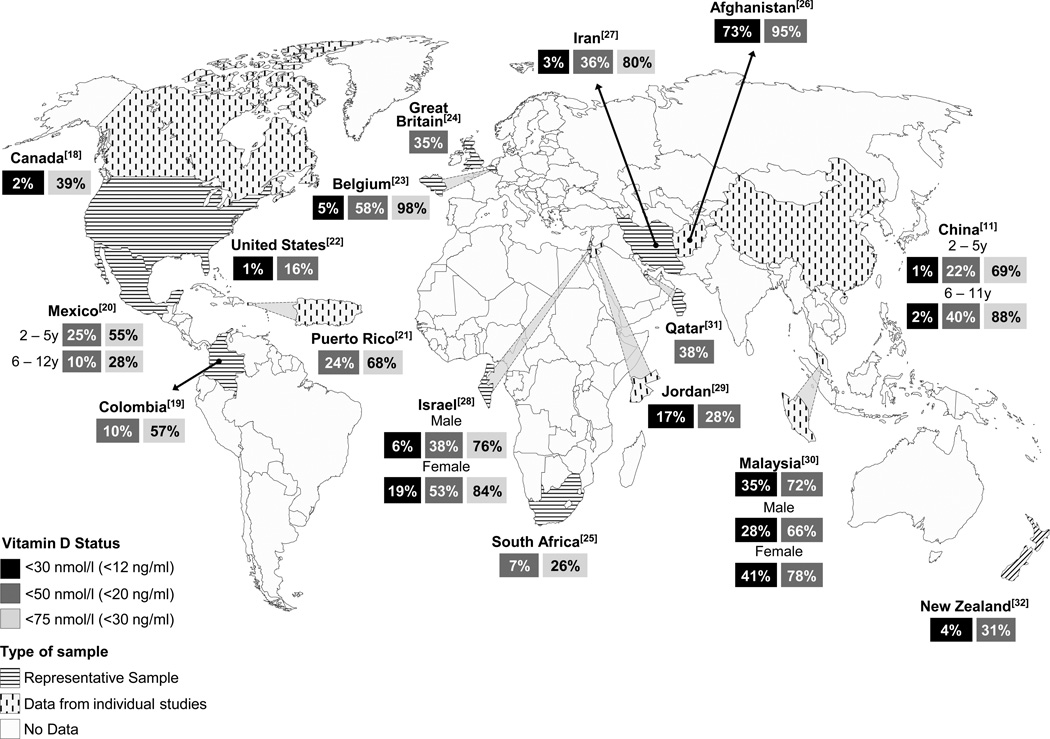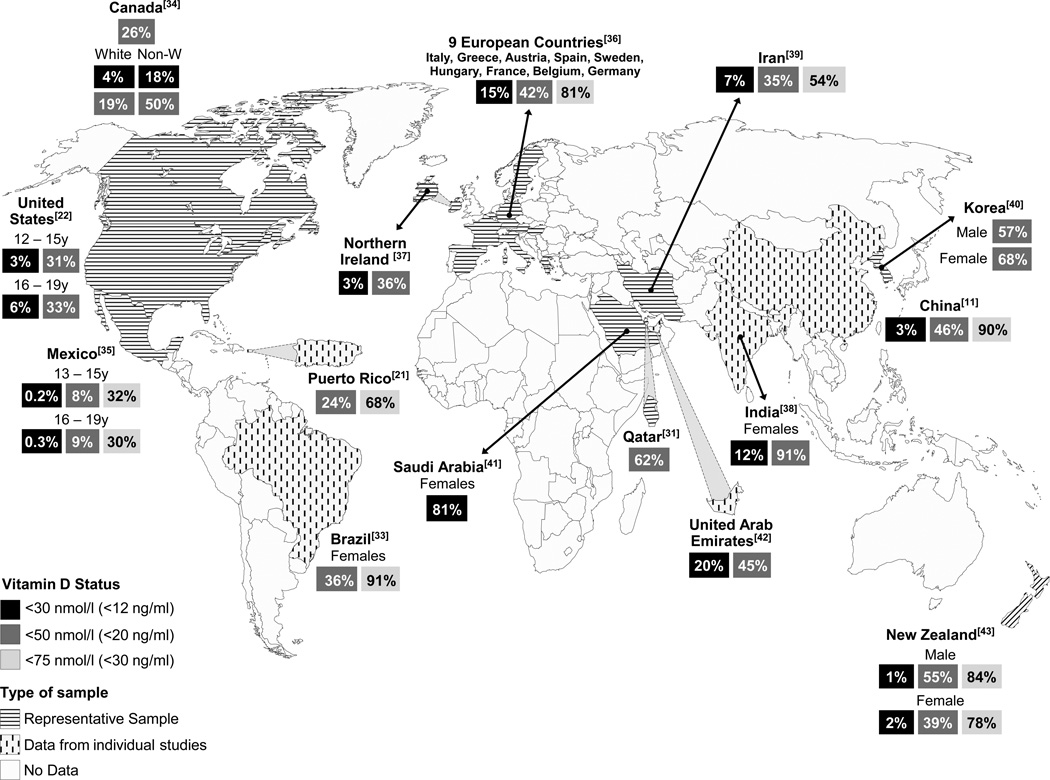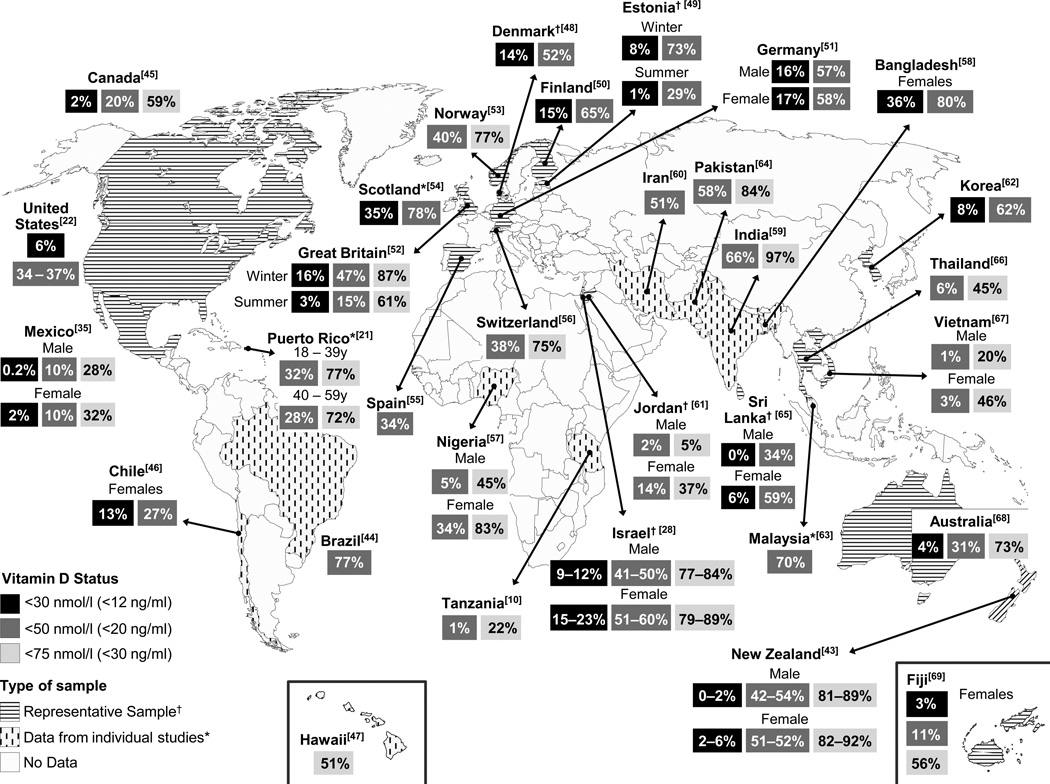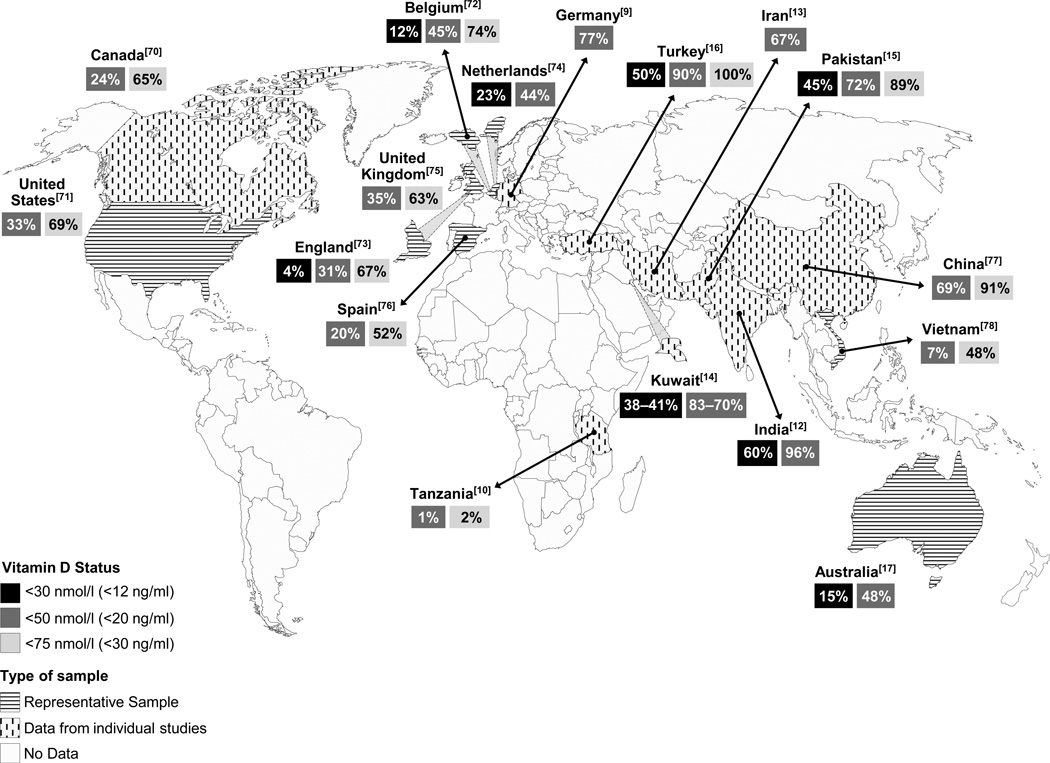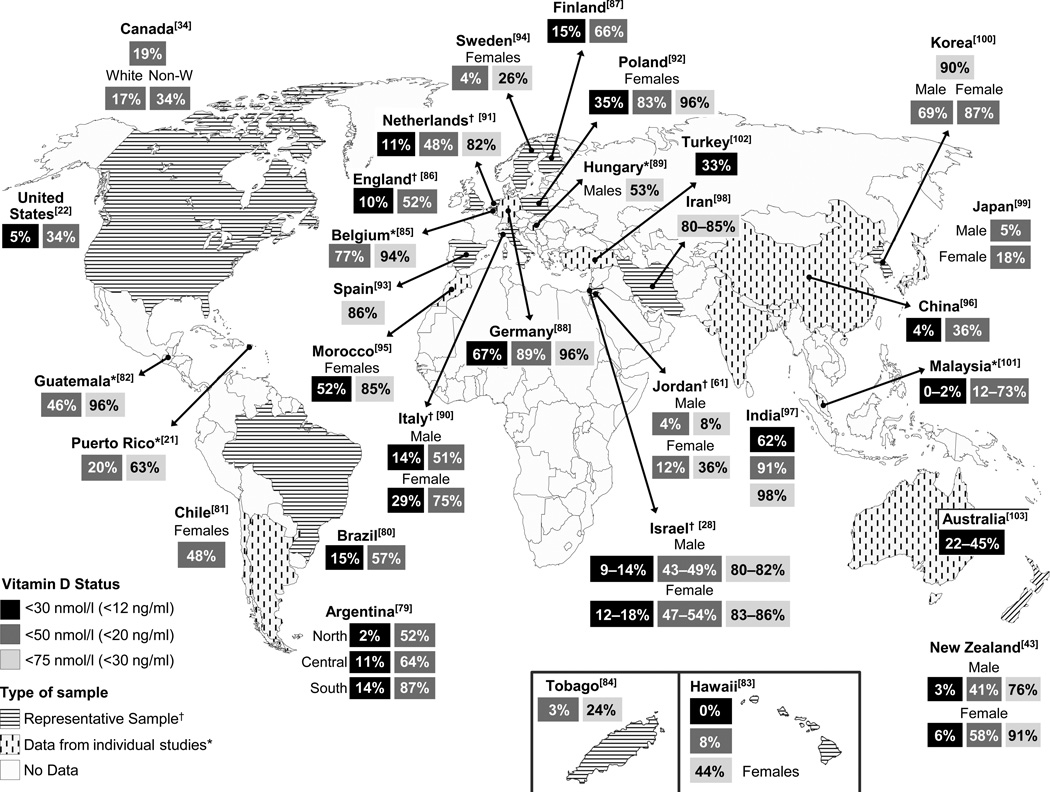Abstract
Vitamin D deficiency is a major public health problem worldwide in all age groups, even in those residing in countries with low latitude, where it was generally assumed that UV radiation was adequate enough to prevent this deficiency, and in industrialized countries, where vitamin D fortification has been implemented now for years. However, most countries are still lacking data, particularly population representative data, with very limited information in infants, children, adolescents and pregnant women. Since the number of recent publications is escalating, with a broadening of the geographic diversity, the objective of the present report was to conduct a more recent systematic review of global vitamin D status, with particular emphasis in at risk groups. A systematic review was conducted in PubMed/Medline in April-June 2013 to identify articles on vitamin D status worldwide published in the last 10 years in apparently healthy individuals. Only studies with vitamin D status prevalence were included. If available, the first source selected was population-based or representative samples studies. Clinical trials, case-control studies, case reports or series, reviews, validation studies, letters, editorials, or qualitative studies were excluded. A total of 103 articles were eligible and included in the present report. Maps were created for each age group, providing an updated overview of global vitamin D status. In areas with available data, the prevalence of low vitamin D status is a global problem in all age groups, in particular in girls and women from the Middle East. These maps also evidenced the regions with missing data for each specific population groups. There is striking lack of data in infants, children and adolescents worldwide, and in most countries of South America and Africa. In conclusion, vitamin D deficiency is a global public health problem in all age groups, particularly in those from the Middle East.
Keywords: vitamin D deficiency, infants, children, adolescents, adults, elder, pregnancy
Introduction
Vitamin D is an essential fat-soluble vitamin for calcium maintenance homeostasis, for bone health and for preventing falls and fractures, and it has also been related to hypertension, diabetes, metabolic syndrome, cancer, autoimmune and infectious diseases, among others (1). These conditions are major public health problems worldwide.
Several reviews have found high prevalence of vitamin D deficiency worldwide (2–4), even in countries with low latitude, where it was generally assumed that UVB radiation was adequate enough to prevent vitamin D deficiency, and in industrialized countries, where vitamin D fortification has been implemented now for years; although substantial fortification has only occurred in a few countries. However, prevalence of vitamin D deficiency worldwide is still uncertain, as there is data lacking from many countries. About 1 billion people have low vitamin D levels and this is found in all ethnicities and age groups (1).
The available reviews illustrate the lack of data in most countries, particularly population representative data, with very limited information in infants, children, adolescents and pregnant women. However, the number of recent publications in this area is escalating, with a broadening of the geographic diversity. Therefore, the objective of the present report was to conduct a systematic review of recent literature on global vitamin D status, with a particular emphasis on at risk groups.
Methods
Identification and selection of studies
A systematic review was conducted in PubMed/Medline in April-June 2013 to identify articles on vitamin D status worldwide published in the last 10 years. Two independent reviewers performed the search using the keywords “vitamin D status or deficiency or insufficiency” or any form for “25(OH)D”.
Eligibility criteria
Only studies in English with data on low vitamin D status prevalence, as determined from serum 25(OH)D levels measured by any method, in apparently healthy individuals were included. If available, the first source selected was population-based studies. If not available, cross-sectional studies were used. Clinical trials, case-control studies, case reports or series, reviews, validation studies, letters, editorials, or qualitative studies were excluded. When available, the data was specified by gender, age, skin pigmentation and season of the year. A total of 3226 articles were identified; after the initial review, 2860 did not meet the inclusion criteria. An additional 263 were excluded after title and abstract reviewing due to very small sample size; a larger sample from the same country was found; use of non-healthy population; no data on prevalence of vitamin D status or duplicated. A total of 103 articles were eligible and included in the present report.
Levels used for vitamin D status
There has been a long debate on the cutoff points for vitamin D status. The Institute of Medicine considers inadequate if 25(OH)D levels are <50 nmol/L (<20 ng/mL) (5). However, many consider inadequate/insufficient if levels are <75 nmol/l (30 ng/mL). For the present analysis, the cutoff points used were: <30 nmol/l (12 ng/mL); <50 nmol/l (<20 ng/mL) and <75 nmol/l (30 ng/mL). When studies used different cut-off points, it was specified.
Maps of vitamin D status worldwide were created for each age group. Corresponding detailed tables can be found in the online version.
Results
Figure 1 shows the prevalence of low vitamin D status in infants worldwide. A total of 12 studies were found; 3 in America, 1 in Europe, 1 in Africa, 6 in Asia, and 1 in Oceania. The highest prevalence of vitamin D deficiency was found in neonates from the Middle East. Figure 2 illustrates the prevalence of low vitamin D status in children worldwide. A total of 17 studies were found; 5 in America, 2 in Europe, 1 in Africa, 8 in Asia and 1 in Oceania. Again, the highest prevalence of vitamin D deficiency was found in children from the Middle East. A total of 15 studies were found reporting the prevalence of low vitamin D status in adolescents (Figure 3); 5 in America, 2 in Europe (1 representing 9 countries), 7 in Asia, 1 in Oceania and none in Africa. The highest prevalence of vitamin D deficiency was found in girls from the Middle East. In adults, a total of 32 studies were found; 7 in America, 9 in Europe, 2 in Africa, 11 in Asia, 3 in Oceania (Figure 4). As with the other age groups, adults from the Middle East had higher deficiency rates, particularly in women. In pregnant and lactating women, a total of 17 studies were found; 2 in America, 6 in Europe, 1 in Africa, 7 in Asia, 1 in Oceania (Figure 5). Very high deficiency rates were found in those from the Middle East. In elders, a total of 31 studies were found; 9 in America, 10 in Europe, 1 in Africa, 9 in Asia, 2 in Oceania (Figure 6). Most countries reported high vitamin D deficiency prevalence.
Figure 1.
Prevalence of low vitamin D status in infants worldwide.
Figure 2.
Prevalence of low vitamin D status in children worldwide.
Figure 3.
Prevalence of low vitamin D status in adolescents worldwide.
Figure 4.
Prevalence of low vitamin D status in adults worldwide.
Figure 5.
Prevalence of low vitamin D status in pregnant or lactating women worldwide.
Figure 6.
Prevalence of low vitamin D status in elders worldwide.
Discussion
This review provides an updated overview of global vitamin D status. In areas with available data, the prevalence of low vitamin D status is a global problem in all age groups, even in countries with sun exposure all year round. It is important to note that the problem is greater in the Middle East, particularly in girls and women. The data also pinpoint the regions with missing data for each specific population groups. There is a striking lack of data in infants, children and adolescents, and in most countries of South America and Africa.
In general, this high prevalence of low vitamin D status may be related to several issues, such as less vitamin D photosynthesis in response to UVB in individuals with high skin melanin content or due to aging, use of extensive skin coverage and scarce exposure to sunlight, which has often been described in individuals from Africa, the Middle East and Central and South America. Moreover, a low vitamin D intake and high rates of obesity worldwide can also contribute to the problem. Season appears to be a small component to the problem worldwide, as countries with long winters have less deficiency rates overall compared to sunny countries, which is probably related to the fortification of staples, consumption of fatty fish and regular use of vitamin D supplements.
There are several limitations of the present report. The data from vitamin D status was derived from a variety of methods used in the different reports. This measurement is difficult, with large variations between methods and between laboratories using the same methods. In addition, there is lacking representative data from many countries, which precludes the ability to accurately assess vitamin D status from such countries; this is particularly important in countries with different latitudes within its territory.
In conclusion, the available data indicates that vitamin D deficiency is a global public health problem, in all age groups, particularly in those from the Middle East.
Supplementary Material
Highlights.
Vitamin D deficiency is a major public health problem worldwide in all age groups.
Low vitamin D status is a problem even in countries with sun exposure all year round.
This problem is particularly high in the Middle East, specially among girls and women.
There is striking lack of vitamin D status data in infants, children and adolescents
There is also lack of data in most countries of South America and Africa.
Acknowledgments
Source of support: this study was supported in part by NIMHHD (8G12-MD007600).
Footnotes
Publisher's Disclaimer: This is a PDF file of an unedited manuscript that has been accepted for publication. As a service to our customers we are providing this early version of the manuscript. The manuscript will undergo copyediting, typesetting, and review of the resulting proof before it is published in its final citable form. Please note that during the production process errors may be discovered which could affect the content, and all legal disclaimers that apply to the journal pertain.
References
- 1.Holick MF, Chen TC. Vitamin D deficiency: a worldwide problem with health consequences. Am. J. Clin. Nutr. 2008;87(4):1080S–1086S. doi: 10.1093/ajcn/87.4.1080S. [DOI] [PubMed] [Google Scholar]
- 2.Mithal A, Wahl DA, Bonjour JP, Burckhardt P, Dawson-Hughes B, Eisman JA, El-Hajj Fuleihan G, Josse RG, Lips P, Morales-Torres J. IOF Committee of Scientific Advisors (CSA) Nutrition Working Group, Global vitamin D status and determinants of hypovitaminosis D. Osteoporos. Int. 2009;20(11):1807–1820. doi: 10.1007/s00198-009-0954-6. [DOI] [PubMed] [Google Scholar]
- 3.van Schoor NM, Lips P. Worldwide vitamin D status. Best Pract. Res. Clin. Endocrinol. Metab. 2011;25(4):671–680. doi: 10.1016/j.beem.2011.06.007. [DOI] [PubMed] [Google Scholar]
- 4.Wahl DA, Cooper C, Ebeling PR, Eggersdorfer M, Hilger J, Hoffmann K, Josse R, Kanis JA, Mithal A, Pierroz DD, Stenmark J, Stocklin E, Dawson-Hughes B. A global representation of vitamin D status in healthy populations. Arch. Osteoporos. 2012;7(1–2):155–172. doi: 10.1007/s11657-012-0093-0. [DOI] [PubMed] [Google Scholar]
- 5.Institute of Medicine, IOM. Dietary Reference Intakes for calcium and Vitamin D. Washington, DC: The National Academy Press; 2011. [Google Scholar]
- 6.Gessner BD, Plotnik J, Muth PT. 25-hydroxyvitamin D levels among healthy children in Alaska. J. Pediatr. 2003;143(4):434–437. doi: 10.1067/S0022-3476(03)00410-4. [DOI] [PubMed] [Google Scholar]
- 7.Duran P, Mangialavori G, Biglieri A, Kogan L, Abeya Gilardon E. Nutrition status in Argentinean children 6 to 72 months old: results from the National Nutrition and Health Survey (ENNyS) Arch. Argent. Pediatr. 2009;107(5):397–404. doi: 10.1590/S0325-00752009000500005. [DOI] [PubMed] [Google Scholar]
- 8.Bodnar LM, Simhan HN, Powers RW, Frank MP, Cooperstein E, Roberts JM. High prevalence of vitamin D insufficiency in black and white pregnant women residing in the northern United States and their neonates. J. Nutr. 2007;137(2):447–452. doi: 10.1093/jn/137.2.447. [DOI] [PMC free article] [PubMed] [Google Scholar]
- 9.Wuertz C, Gilbert P, Baier W, Kunz C. Cross-sectional study of factors that influence the 25-hydroxyvitamin D status in pregnant women and in cord blood in Germany. Br. J. Nutr. 2013:1–8. doi: 10.1017/S0007114513001438. [DOI] [PubMed] [Google Scholar]
- 10.Luxwolda MF, Kuipers RS, Kema IP, van der Veer E, Dijck-Brouwer DA, Muskiet FA. Vitamin D status indicators in indigenous populations in East Africa. Eur. J. Nutr. 2013;52(3):1115–1125. doi: 10.1007/s00394-012-0421-6. [DOI] [PubMed] [Google Scholar]
- 11.Zhu Z, Zhan J, Shao J, Chen W, Chen L, Li W, Ji C, Zhao Z. High prevalence of vitamin D deficiency among children aged 1 month to 16 years in Hangzhou, China. BMC Public Health. 2012;12 doi: 10.1186/1471-2458-12-126. 126-2458-12-126. [DOI] [PMC free article] [PubMed] [Google Scholar]
- 12.Marwaha RK, Tandon N, Chopra S, Agarwal N, Garg MK, Sharma B, Kanwar RS, Bhadra K, Singh S, Mani K, Puri S. Vitamin D status in pregnant Indian women across trimesters and different seasons and its correlation with neonatal serum 25-hydroxyvitamin D levels. Br. J. Nutr. 2011;106(9):1383–1389. doi: 10.1017/S000711451100170X. [DOI] [PubMed] [Google Scholar]
- 13.Maghbooli Z, Hossein-Nezhad A, Shafaei AR, Karimi F, Madani FS, Larijani B. Vitamin D status in mothers and their newborns in Iran. BMC Pregnancy Childbirth. 2007;7:1. doi: 10.1186/1471-2393-7-1. [DOI] [PMC free article] [PubMed] [Google Scholar]
- 14.Molla AM, Al Badawi M, Hammoud MS, Molla AM, Shukkur M, Thalib L, Eliwa MS. Vitamin D status of mothers and their neonates in Kuwait. Pediatr. Int. 2005;47(6):649–652. doi: 10.1111/j.1442-200x.2005.02141.x. [DOI] [PubMed] [Google Scholar]
- 15.Hossain N, Khanani R, Hussain-Kanani F, Shah T, Arif S, Pal L. High prevalence of vitamin D deficiency in Pakistani mothers and their newborns. Int. J. Gynaecol. Obstet. 2011;112(3):229–233. doi: 10.1016/j.ijgo.2010.09.017. [DOI] [PubMed] [Google Scholar]
- 16.Halicioglu O, Aksit S, Koc F, Akman SA, Albudak E, Yaprak I, Coker I, Colak A, Ozturk C, Gulec ES. Vitamin D deficiency in pregnant women and their neonates in spring time in western Turkey. Paediatr. Perinat. Epidemiol. 2012;26(1):53–60. doi: 10.1111/j.1365-3016.2011.01238.x. [DOI] [PubMed] [Google Scholar]
- 17.Bowyer L, Catling-Paull C, Diamond T, Homer C, Davis G, Craig ME. Vitamin D, PTH and calcium levels in pregnant women and their neonates. Clin. Endocrinol. (Oxf) 2009;70(3):372–377. doi: 10.1111/j.1365-2265.2008.03316.x. [DOI] [PubMed] [Google Scholar]
- 18.Stoian CA, Lyon M, Cox RG, Stephure DK, Mah JK. Vitamin D concentrations among healthy children in Calgary, Alberta. Paediatr. Child. Health. 2011;16(2):82–86. doi: 10.1093/pch/16.2.82. [DOI] [PMC free article] [PubMed] [Google Scholar]
- 19.Gilbert-Diamond D, Baylin A, Mora-Plazas M, Marin C, Arsenault JE, Hughes MD, Willett WC, Villamor E. Vitamin D deficiency and anthropometric indicators of adiposity in school-age children: a prospective study. Am. J. Clin. Nutr. 2010;92(6):1446–1451. doi: 10.3945/ajcn.2010.29746. [DOI] [PMC free article] [PubMed] [Google Scholar]
- 20.Flores M, Macias N, Lozada A, Sanchez LM, Diaz E, Barquera S. Serum 25-hydroxyvitamin D levels among Mexican children ages 2 y to 12 y: a national survey. Nutrition. 2013;29(5):802–804. doi: 10.1016/j.nut.2012.12.024. [DOI] [PubMed] [Google Scholar]
- 21.Suárez-Martínez; EB, Pérez CM, Cruz SK, Khorsandi S, Chardón C, Ferder L. Importance of Vitamin D: Role in Cardiovascular Disease and Status in Puerto Ricans. Journal of Health Care for the Poor and Underserved. doi: 10.1353/hpu.2014.0000. (In Press) [DOI] [PMC free article] [PubMed] [Google Scholar]
- 22.Ganji V, Zhang X, Tangpricha V. Serum 25-hydroxyvitamin D concentrations and prevalence estimates of hypovitaminosis D in the U.S. population based on assay-adjusted data. J. Nutr. 2012;142(3):498–507. doi: 10.3945/jn.111.151977. [DOI] [PubMed] [Google Scholar]
- 23.Sioen I, Mouratidou T, Kaufman JM, Bammann K, Michels N, Pigeot I, Vanaelst B, Vyncke K, De Henauw S. IDEFICS consortium, Determinants of vitamin D status in young children: results from the Belgian arm of the IDEFICS (Identification and Prevention of Dietary- and Lifestyle-Induced Health Effects in Children and Infants) Study. Public Health Nutr. 2012;15(6):1093–1099. doi: 10.1017/S1368980011002989. [DOI] [PubMed] [Google Scholar]
- 24.Absoud M, Cummins C, Lim MJ, Wassmer E, Shaw N. Prevalence and predictors of vitamin D insufficiency in children: a Great Britain population based study. PLoS One. 2011;6(7):e22179. doi: 10.1371/journal.pone.0022179. [DOI] [PMC free article] [PubMed] [Google Scholar]
- 25.Poopedi MA, Norris SA, Pettifor JM. Factors influencing the vitamin D status of 10-year-old urban South African children. Public Health Nutr. 2011;14(2):334–339. doi: 10.1017/S136898001000234X. [DOI] [PubMed] [Google Scholar]
- 26.Manaseki-Holland S, Zulf Mughal M, Bhutta Z, Qasem Shams M. Vitamin D status of socio-economically deprived children in Kabul, Afghanistan. Int. J. Vitam. Nutr. Res. 2008;78(1):16–20. doi: 10.1024/0300-9831.78.1.16. [DOI] [PubMed] [Google Scholar]
- 27.Olang B, Naghavi M, Bastani D, Strandvik B, Yngve A. Optimal vitamin A and suboptimal vitamin D status are common in Iranian infants. Acta Paediatr. 2011;100(3):439–444. doi: 10.1111/j.1651-2227.2010.02058.x. [DOI] [PubMed] [Google Scholar]
- 28.Saliba W, Rennert HS, Kershenbaum A, Rennert G. Serum 25(OH)D concentrations in sunny Israel. Osteoporos. Int. 2012;23(2):687–694. doi: 10.1007/s00198-011-1597-y. [DOI] [PubMed] [Google Scholar]
- 29.Abdul-Razzak KK, Ajlony MJ, Khoursheed AM, Obeidat BA. Vitamin D deficiency among healthy infants and toddlers: a prospective study from Irbid, Jordan. Pediatr. Int. 2011;53(6):839–845. doi: 10.1111/j.1442-200X.2011.03388.x. [DOI] [PubMed] [Google Scholar]
- 30.Khor GL, Chee WS, Shariff ZM, Poh BK, Arumugam M, Rahman JA, Theobald HE. High prevalence of vitamin D insufficiency and its association with BMI-for-age among primary school children in Kuala Lumpur, Malaysia. BMC Public Health. 2011;11 doi: 10.1186/1471-2458-11-95. 95-2458-11-95. [DOI] [PMC free article] [PubMed] [Google Scholar]
- 31.Bener A, Al-Ali M, Hoffmann GF. Vitamin D deficiency in healthy children in a sunny country: associated factors. Int. J. Food Sci. Nutr. 2009;60(Suppl 5):60–70. doi: 10.1080/09637480802400487. [DOI] [PubMed] [Google Scholar]
- 32.Rockell JE, Green TJ, Skeaff CM, Whiting SJ, Taylor RW, Williams SM, Parnell WR, Scragg R, Wilson N, Schaaf D, Fitzgerald ED, Wohlers MW. Season and ethnicity are determinants of serum 25-hydroxyvitamin D concentrations in New Zealand children aged 5–14 y. J. Nutr. 2005;135(11):2602–2608. doi: 10.1093/jn/135.11.2602. [DOI] [PubMed] [Google Scholar]
- 33.Santos BR, Mascarenhas LP, Satler F, Boguszewski MC, Spritzer PM. Vitamin D deficiency in girls from South Brazil: a cross-sectional study on prevalence and association with vitamin D receptor gene variants. BMC Pediatr. 2012;12 doi: 10.1186/1471-2431-12-62. 62-2431-12-62. [DOI] [PMC free article] [PubMed] [Google Scholar]
- 34.Whiting SJ, Langlois KA, Vatanparast H, Greene-Finestone LS. The vitamin D status of Canadians relative to the 2011 Dietary Reference Intakes: an examination in children and adults with and without supplement use. Am. J. Clin. Nutr. 2011;94(1):128–135. doi: 10.3945/ajcn.111.013268. [DOI] [PubMed] [Google Scholar]
- 35.Flores M, Sánchez-Romero LM, Macías N, Lozada A, Díaz E, Barquera S. Resultados de la ENSANUT 2006. Cuernavaca, México: Instituto Nacional de Salud Pública; 2011. Concentraciones séricas de vitamina D en niños, adolescentes y adultos mexicanos. Available at: http://www.insp.mx/images/stories/Centros/cinys/Docs/111202_ReporteVitaminaD.pdf. [Google Scholar]
- 36.Gonzalez-Gross M, Valtuena J, Breidenassel C, Moreno LA, Ferrari M, Kersting M, De Henauw S, Gottrand F, Azzini E, Widhalm K, Kafatos A, Manios Y, Stehle P. HELENA Study Group, Vitamin D status among adolescents in Europe: the Healthy Lifestyle in Europe by Nutrition in Adolescence study. Br. J. Nutr. 2012;107(5):755–764. doi: 10.1017/S0007114511003527. [DOI] [PubMed] [Google Scholar]
- 37.Hill TR, Cotter AA, Mitchell S, Boreham CA, Dubitzky W, Murray L, Strain JJ, Flynn A, Robson PJ, Wallace JM, Kiely M, Cashman KD. Vitamin D status and its determinants in adolescents from the Northern Ireland Young Hearts 2000 cohort. Br. J. Nutr. 2008;99(5):1061–1067. doi: 10.1017/S0007114507842826. [DOI] [PubMed] [Google Scholar]
- 38.Puri S, Marwaha RK, Agarwal N, Tandon N, Agarwal R, Grewal K, Reddy DH, Singh S. Vitamin D status of apparently healthy schoolgirls from two different socioeconomic strata in Delhi: relation to nutrition and lifestyle. Br. J. Nutr. 2008;99(4):876–882. doi: 10.1017/S0007114507831758. [DOI] [PubMed] [Google Scholar]
- 39.Rabbani A, Alavian SM, Motlagh ME, Ashtiani MT, Ardalan G, Salavati A, Rabbani B, Rabbani A, Shams S, Parvaneh N. Vitamin D insufficiency among children and adolescents living in Tehran, Iran. J. Trop. Pediatr. 2009;55(3):189–191. doi: 10.1093/tropej/fmn078. [DOI] [PubMed] [Google Scholar]
- 40.Choi HS, Oh HJ, Choi H, Choi WH, Kim JG, Kim KM, Kim KJ, Rhee Y, Lim SK. Vitamin D insufficiency in Korea--a greater threat to younger generation: the Korea National Health and Nutrition Examination Survey (KNHANES) 2008. J. Clin. Endocrinol. Metab. 2011;96(3):643–651. doi: 10.1210/jc.2010-2133. [DOI] [PubMed] [Google Scholar]
- 41.Siddiqui AM, Kamfar HZ. Prevalence of vitamin D deficiency rickets in adolescent school girls in Western region, Saudi Arabia. Saudi Med. J. 2007;28(3):441–444. [PubMed] [Google Scholar]
- 42.Muhairi SJ, Mehairi AE, Khouri AA, Naqbi MM, Maskari FA, Al Kaabi J, Al Dhaheri AS, Nagelkerke N, Shah SM. Vitamin D deficiency among healthy adolescents in Al Ain, United Arab Emirates. BMC Public Health. 2013;13 doi: 10.1186/1471-2458-13-33. 33-2458-13-33. [DOI] [PMC free article] [PubMed] [Google Scholar]
- 43.Rockell JE, Skeaff CM, Williams SM, Green TJ. Serum 25-hydroxyvitamin D concentrations of New Zealanders aged 15 years and older. Osteoporos. Int. 2006;17(9):1382–1389. doi: 10.1007/s00198-006-0118-x. [DOI] [PubMed] [Google Scholar]
- 44.Unger MD, Cuppari L, Titan SM, Magalhaes MC, Sassaki AL, dos Reis LM, Jorgetti V, Moyses RM. Vitamin D status in a sunny country: where has the sun gone? Clin. Nutr. 2010;29(6):784–788. doi: 10.1016/j.clnu.2010.06.009. [DOI] [PubMed] [Google Scholar]
- 45.Greene-Finestone LS, Berger C, de Groh M, Hanley DA, Hidiroglou N, Sarafin K, Poliquin S, Krieger J, Richards JB, Goltzman D. CaMos Research Group, 25-Hydroxyvitamin D in Canadian adults: biological, environmental, and behavioral correlates. Osteoporos. Int. 2011;22(5):1389–1399. doi: 10.1007/s00198-010-1362-7. [DOI] [PMC free article] [PubMed] [Google Scholar]
- 46.Gonzalez G, Alvarado JN, Rojas A, Navarrete C, Velasquez CG, Arteaga E. High prevalence of vitamin D deficiency in Chilean healthy postmenopausal women with normal sun exposure: additional evidence for a worldwide concern. Menopause. 2007;14(3 Pt 1):455–461. doi: 10.1097/GME.0b013e31802c54c0. [DOI] [PubMed] [Google Scholar]
- 47.Binkley N, Novotny R, Krueger D, Kawahara T, Daida YG, Lensmeyer G, Hollis BW, Drezner MK. Low vitamin D status despite abundant sun exposure. J. Clin. Endocrinol. Metab. 2007;92(6):2130–2135. doi: 10.1210/jc.2006-2250. [DOI] [PubMed] [Google Scholar]
- 48.Thuesen B, Husemoen L, Fenger M, Jakobsen J, Schwarz P, Toft U, Ovesen L, Jorgensen T, Linneberg A. Determinants of vitamin D status in a general population of Danish adults. Bone. 2012;50(3):605–610. doi: 10.1016/j.bone.2011.12.016. [DOI] [PubMed] [Google Scholar]
- 49.Kull M, Jr, Kallikorm R, Tamm A, Lember M. Seasonal variance of 25-(OH) vitamin D in the general population of Estonia, a Northern European country. BMC Public Health. 2009;9 doi: 10.1186/1471-2458-9-22. 22-2458-9-22. [DOI] [PMC free article] [PubMed] [Google Scholar]
- 50.Virtanen JK, Nurmi T, Voutilainen S, Mursu J, Tuomainen TP. Association of serum 25-hydroxyvitamin D with the risk of death in a general older population in Finland. Eur. J. Nutr. 2011;50(5):305–312. doi: 10.1007/s00394-010-0138-3. [DOI] [PubMed] [Google Scholar]
- 51.Hintzpeter B, Mensink GB, Thierfelder W, Muller MJ, Scheidt-Nave C. Vitamin D status and health correlates among German adults. Eur. J. Clin. Nutr. 2008;62(9):1079–1089. doi: 10.1038/sj.ejcn.1602825. [DOI] [PubMed] [Google Scholar]
- 52.Hypponen E, Power C. Hypovitaminosis D in British adults at age 45 y: nationwide cohort study of dietary and lifestyle predictors. Am. J. Clin. Nutr. 2007;85(3):860–868. doi: 10.1093/ajcn/85.3.860. [DOI] [PubMed] [Google Scholar]
- 53.Mai XM, Chen Y, Camargo CA, Jr, Langhammer A. Cross-sectional and prospective cohort study of serum 25-hydroxyvitamin D level and obesity in adults: the HUNT study. Am. J. Epidemiol. 2012;175(10):1029–1036. doi: 10.1093/aje/kwr456. [DOI] [PubMed] [Google Scholar]
- 54.Zgaga L, Theodoratou E, Farrington SM, Agakov F, Tenesa A, Walker M, Knox S, Wallace AM, Cetnarskyj R, McNeill G, Kyle J, Porteous ME, Dunlop MG, Campbell H. Diet, environmental factors, and lifestyle underlie the high prevalence of vitamin D deficiency in healthy adults in Scotland, and supplementation reduces the proportion that are severely deficient. J. Nutr. 2011;141(8):1535–1542. doi: 10.3945/jn.111.140012. [DOI] [PMC free article] [PubMed] [Google Scholar]
- 55.Gonzalez-Molero I, Morcillo S, Valdes S, Perez-Valero V, Botas P, Delgado E, Hernandez D, Olveira G, Rojo G, Gutierrez-Repiso C, Rubio-Martin E, Menendez E, Soriguer F. Vitamin D deficiency in Spain: a population-based cohort study. Eur. J. Clin. Nutr. 2011;65(3):321–328. doi: 10.1038/ejcn.2010.265. [DOI] [PubMed] [Google Scholar]
- 56.Guessous I, Dudler V, Glatz N, Theler JM, Zoller O, Paccaud F, Burnier M, Bochud M. Swiss Survey on Salt Group, Vitamin D levels and associated factors: a population-based study in Switzerland. Swiss Med. Wkly. 2012;142:0. doi: 10.4414/smw.2012.13719. [DOI] [PubMed] [Google Scholar]
- 57.Glew RH, Crossey MJ, Polanams J, Okolie HI, VanderJagt DJ. Vitamin D status of seminomadic Fulani men and women. J. Natl. Med. Assoc. 2010;102(6):485–490. doi: 10.1016/s0027-9684(15)30556-3. [DOI] [PubMed] [Google Scholar]
- 58.Islam MZ, Akhtaruzzaman M, Lamberg-Allardt C. Hypovitaminosis D is common in both veiled and nonveiled Bangladeshi women. Asia Pac. J. Clin. Nutr. 2006;15(1):81–87. [PubMed] [Google Scholar]
- 59.Majumdar V, Nagaraja D, Christopher R. Vitamin D status and metabolic syndrome in Asian Indians. Int. J. Obes. (Lond) 2011;35(8):1131–1134. doi: 10.1038/ijo.2010.232. [DOI] [PubMed] [Google Scholar]
- 60.Hovsepian S, Amini M, Aminorroaya A, Amini P, Iraj B. Prevalence of vitamin D deficiency among adult population of Isfahan City, Iran. J. Health Popul. Nutr. 2011;29(2):149–155. doi: 10.3329/jhpn.v29i2.7857. [DOI] [PMC free article] [PubMed] [Google Scholar]
- 61.Batieha A, Khader Y, Jaddou H, Hyassat D, Batieha Z, Khateeb M, Belbisi A, Ajlouni K. Vitamin D status in Jordan: dress style and gender discrepancies. Ann. Nutr. Metab. 2011;58(1):10–18. doi: 10.1159/000323097. [DOI] [PubMed] [Google Scholar]
- 62.Rhee SY, Hwang YC, Chung HY, Woo JT. Vitamin D and diabetes in Koreans: analyses based on the Fourth Korea National Health and Nutrition Examination Survey (KNHANES), 2008–2009. Diabet. Med. 2012;29(8):1003–1010. doi: 10.1111/j.1464-5491.2012.03575.x. [DOI] [PMC free article] [PubMed] [Google Scholar]
- 63.Moy FM, Bulgiba A. High prevalence of vitamin D insufficiency and its association with obesity and metabolic syndrome among Malay adults in Kuala Lumpur, Malaysia. BMC Public Health. 2011;11 doi: 10.1186/1471-2458-11-735. 735-2458-11-735. [DOI] [PMC free article] [PubMed] [Google Scholar]
- 64.Sheikh A, Saeed Z, Jafri SA, Yazdani I, Hussain SA. Vitamin D levels in asymptomatic adults--a population survey in Karachi, Pakistan. PLoS One. 2012;7(3):e33452. doi: 10.1371/journal.pone.0033452. [DOI] [PMC free article] [PubMed] [Google Scholar]
- 65.Meyer HE, Holvik K, Lofthus CM, Tennakoon SU. Vitamin D status in Sri Lankans living in Sri Lanka and Norway. Br. J. Nutr. 2008;99(5):941–944. doi: 10.1017/S0007114507844138. [DOI] [PubMed] [Google Scholar]
- 66.Chailurkit LO, Aekplakorn W, Ongphiphadhanakul B. Regional variation and determinants of vitamin D status in sunshine-abundant Thailand. BMC Public Health. 2011;11 doi: 10.1186/1471-2458-11-853. 853-2458-11-853. [DOI] [PMC free article] [PubMed] [Google Scholar]
- 67.Ho-Pham LT, Nguyen ND, Lai TQ, Eisman JA, Nguyen TV. Vitamin D status and parathyroid hormone in a urban population in Vietnam. Osteoporos. Int. 2011;22(1):241–248. doi: 10.1007/s00198-010-1207-4. [DOI] [PubMed] [Google Scholar]
- 68.Daly RM, Gagnon C, Lu ZX, Magliano DJ, Dunstan DW, Sikaris KA, Zimmet PZ, Ebeling PR, Shaw JE. Prevalence of vitamin D deficiency and its determinants in Australian adults aged 25 years and older: a national, population-based study. Clin. Endocrinol. (Oxf) 2012;77(1):26–35. doi: 10.1111/j.1365-2265.2011.04320.x. [DOI] [PubMed] [Google Scholar]
- 69.Heere C, Skeaff CM, Waqatakirewa L, Vatucawaqa P, Khan AN, Green TJ. Serum 25-hydroxyvitamin D concentration of Indigenous-Fijian and Fijian-Indian women. Asia Pac. J. Clin. Nutr. 2010;19(1):43–48. [PubMed] [Google Scholar]
- 70.Li W, Green TJ, Innis SM, Barr SI, Whiting SJ, Shand A, von Dadelszen P. Suboptimal vitamin D levels in pregnant women despite supplement use. Can. J. Public Health. 2011;102(4):308–312. doi: 10.1007/BF03404056. [DOI] [PMC free article] [PubMed] [Google Scholar]
- 71.Ginde AA, Sullivan AF, Mansbach JM, Camargo CA., Jr Vitamin D insufficiency in pregnant and nonpregnant women of childbearing age in the United States. Am. J. Obstet. Gynecol. 2010;202(5):436.e1–436.e8. doi: 10.1016/j.ajog.2009.11.036. [DOI] [PMC free article] [PubMed] [Google Scholar]
- 72.Vandevijvere, Amsalkhir Stefanie, Van Oyen Sihame, Moreno-Reyes Herman, Rodrigo High Prevalence of Vitamin D Deficiency in Pregnant Women: A National Cross-Sectional Survey. PLoS ONE. 2012;7(8):e43868. doi: 10.1371/journal.pone.0043868. [DOI] [PMC free article] [PubMed] [Google Scholar]
- 73.Sullivan S, Wills A, Lawlor D, McGrath J, Zammit S. Prenatal vitamin D status and risk of psychotic experiences at age 18years-a longitudinal birth cohort. Schizophr. Res. 2013 doi: 10.1016/j.schres.2013.05.015. [DOI] [PubMed] [Google Scholar]
- 74.Brandenbarg J, Vrijkotte TG, Goedhart G, van Eijsden M. Maternal early-pregnancy vitamin D status is associated with maternal depressive symptoms in the Amsterdam Born Children and Their Development cohort. Psychosom. Med. 2012;74(7):751–757. doi: 10.1097/PSY.0b013e3182639fdb. [DOI] [PubMed] [Google Scholar]
- 75.Crozier SR, Harvey NC, Inskip HM, Godfrey KM, Cooper C, Robinson SM. SWS Study Group, Maternal vitamin D status in pregnancy is associated with adiposity in the offspring: findings from the Southampton Women's Survey. Am. J. Clin. Nutr. 2012;96(1):57–63. doi: 10.3945/ajcn.112.037473. [DOI] [PMC free article] [PubMed] [Google Scholar]
- 76.Morales E, Guxens M, Llop S, Rodriguez-Bernal CL, Tardon A, Riano I, Ibarluzea J, Lertxundi N, Espada M, Rodriguez A, Sunyer J. INMA Project, Circulating 25-hydroxyvitamin D3 in pregnancy and infant neuropsychological development. Pediatrics. 2012;130(4):e913–e920. doi: 10.1542/peds.2011-3289. [DOI] [PubMed] [Google Scholar]
- 77.Tao M, Shao H, Gu J, Zhen Z. Vitamin D status of pregnant women in Shanghai, China. J. Matern. Fetal. Neonatal Med. 2012;25(3):237–239. doi: 10.3109/14767058.2011.569613. [DOI] [PubMed] [Google Scholar]
- 78.Hien VT, Lam NT, Skeaff CM, Todd J, McLean JM, Green TJ. Vitamin D status of pregnant and non-pregnant women of reproductive age living in Hanoi City and the Hai Duong province of Vietnam. Matern. Child. Nutr. 2012;8(4):533–539. doi: 10.1111/j.1740-8709.2011.00327.x. [DOI] [PMC free article] [PubMed] [Google Scholar]
- 79.Oliveri B, Plantalech L, Bagur A, Wittich AC, Rovai G, Pusiol E, Lopez Giovanelli J, Ponce G, Nieva A, Chaperon A, Ladizesky M, Somoza J, Casco C, Zeni S, Parisi MS, Mautalen CA. High prevalence of vitamin D insufficiency in healthy elderly people living at home in Argentina. Eur. J. Clin. Nutr. 2004;58(2):337–342. doi: 10.1038/sj.ejcn.1601786. [DOI] [PubMed] [Google Scholar]
- 80.Saraiva GL, Cendoroglo MS, Ramos LR, Araujo LM, Vieira JG, Kunii I, Hayashi LF, Correa MP, Lazaretti-Castro M. Influence of ultraviolet radiation on the production of 25 hydroxyvitamin D in the elderly population in the city of Sao Paulo (23 degrees 34'S), Brazil . Osteoporos. Int. 2005;16(12):1649–1654. doi: 10.1007/s00198-005-1895-3. [DOI] [PubMed] [Google Scholar]
- 81.Rodriguez PJA, Valdivia CG, Trincado MP. Vertebral fractures, osteoporosis and vitamin D levels in Chilean postmenopausal women. Rev. Med. Chil. 2007;135(1):31–36. doi: 10.4067/s0034-98872007000100005. [DOI] [PubMed] [Google Scholar]
- 82.Sud SR, Montenegro-Bethancourt G, Bermudez OI, Heaney RP, Armas L, Solomons NW. Older Mayan residents of the western highlands of Guatemala lack sufficient levels of vitamin D. Nutr. Res. 2010;30(11):739–746. doi: 10.1016/j.nutres.2010.10.003. [DOI] [PubMed] [Google Scholar]
- 83.Pramyothin P, Techasurungkul S, Lin J, Wang H, Shah A, Ross PD, Puapong R, Wasnich RD. Vitamin D status and falls, frailty, and fractures among postmenopausal Japanese women living in Hawaii. Osteoporos. Int. 2009;20(11):1955–1962. doi: 10.1007/s00198-009-0910-5. [DOI] [PubMed] [Google Scholar]
- 84.Miljkovic I, Bodnar LM, Cauley JA, Bunker CH, Patrick AL, Wheeler VW, Kuller LH, Zmuda JM. Low prevalence of vitamin D deficiency in elderly Afro-Caribbean men. Ethn. Dis. 2011;21(1):79–84. [PMC free article] [PubMed] [Google Scholar]
- 85.Verhoeven V, Vanpuyenbroeck K, Lopez-Hartmann M, Wens J, Remmen R. Walk on the sunny side of life--epidemiology of hypovitaminosis D and mental health in elderly nursing home residents. J. Nutr. Health Aging. 2012;16(4):417–420. doi: 10.1007/s12603-011-0361-5. [DOI] [PubMed] [Google Scholar]
- 86.Hirani V. Associations between vitamin d and self-reported respiratory disease in older people from a nationally representative population survey. J. Am. Geriatr. Soc. 2013;61(6):969–973. doi: 10.1111/jgs.12254. [DOI] [PubMed] [Google Scholar]
- 87.Hurskainen A, Virtanen JK, Tuomainen T, Nurmi T, Voutilainen S. Association of serum 25-hydroxyvitamin D with type 2 diabetes and markers of insulin resistance in a general older population in Finland. Diabetes. Metab. Res. 2012;28(5):418–423. doi: 10.1002/dmrr.2286. [DOI] [PubMed] [Google Scholar]
- 88.Schilling S. Epidemic vitamin D deficiency among patients in an elderly care rehabilitation facility. Dtsch. Arztebl Int. 2012;109(3):33–38. doi: 10.3238/arztebl.2012.0033. [DOI] [PMC free article] [PubMed] [Google Scholar]
- 89.Bhattoa HP, Nagy E, More C, Kappelmayer J, Balogh A, Kalina E, Antal-Szalmas P. Prevalence and seasonal variation of hypovitaminosis D and its relationship to bone metabolism in healthy Hungarian men over 50 years of age: the HunMen Study. Osteoporos. Int. 2013;24(1):179–186. doi: 10.1007/s00198-012-1920-2. [DOI] [PubMed] [Google Scholar]
- 90.Houston DK, Cesari M, Ferrucci L, Cherubini A, Maggio D, Bartali B, Johnson MA, Schwartz GG, Kritchevsky SB. Association between vitamin D status and physical performance: the InCHIANTI study. J. Gerontol. A Biol. Sci. Med. Sci. 2007;62(4):440–446. doi: 10.1093/gerona/62.4.440. [DOI] [PMC free article] [PubMed] [Google Scholar]
- 91.Oosterwerff MM, Eekhoff EM, Heymans MW, Lips P, van Schoor NM. Serum 25-hydroxyvitamin D levels and the metabolic syndrome in older persons: a population-based study. Clin. Endocrinol. (Oxf) 2011;75(5):608–613. doi: 10.1111/j.1365-2265.2011.04110.x. [DOI] [PubMed] [Google Scholar]
- 92.Napiorkowska L, Budlewski T, Jakubas-Kwiatkowska W, Hamzy V, Gozdowski D, Franek E. Prevalence of low serum vitamin D concentration in an urban population of elderly women in Poland. Pol. Arch. Med. Wewn. 2009;119(11):699–703. [PubMed] [Google Scholar]
- 93.Almirall J, Vaqueiro M, Bare ML, Anton E. Association of low serum 25-hydroxyvitamin D levels and high arterial blood pressure in the elderly. Nephrol. Dial. Transplant. 2010;25(2):503–509. doi: 10.1093/ndt/gfp470. [DOI] [PubMed] [Google Scholar]
- 94.Gerdhem P, Ringsberg KA, Obrant KJ, Akesson K. Association between 25-hydroxy vitamin D levels, physical activity, muscle strength and fractures in the prospective population-based OPRA Study of Elderly Women. Osteoporos. Int. 2005;16(11):1425–1431. doi: 10.1007/s00198-005-1860-1. [DOI] [PubMed] [Google Scholar]
- 95.El Maghraoui A, Ouzzif Z, Mounach A, Rezqi A, Achemlal L, Bezza A, Tellal S, Dehhaoui M, Ghozlani I. Hypovitaminosis D and prevalent asymptomatic vertebral fractures in Moroccan postmenopausal women. BMC Womens Health. 2012;12(1):11. doi: 10.1186/1472-6874-12-11. [DOI] [PMC free article] [PubMed] [Google Scholar]
- 96.Lu HK, Zhang Z, Ke YH, He JW, Fu WZ, Zhang CQ, Zhang ZL. High prevalence of vitamin D insufficiency in China: relationship with the levels of parathyroid hormone and markers of bone turnover. PLoS One. 2012;7(11):e47264. doi: 10.1371/journal.pone.0047264. [DOI] [PMC free article] [PubMed] [Google Scholar]
- 97.Marwaha RK, Tandon N, Garg MK, Kanwar R, Narang A, Sastry A, Saberwal A, Bandra K. Vitamin D status in healthy Indians aged 50 years and above. J. Assoc. Physicians India. 2011;59:706–709. [PubMed] [Google Scholar]
- 98.Maddah M, Sharami SH, Neyestani TR. Vitamin D insufficiency among postmenopausal women in urban and rural areas in Guilan, Northern Iran. J. Nutr. Elder. 2009;28(4):386–393. doi: 10.1080/01639360903393523. [DOI] [PubMed] [Google Scholar]
- 99.Suzuki T, Kwon J, Kim H, Shimada H, Yoshida Y, Iwasa H, Yoshida H. Low serum 25-hydroxyvitamin D levels associated with falls among Japanese community-dwelling elderly. J. Bone Miner. Res. 2008;23(8):1309–1317. doi: 10.1359/jbmr.080328. [DOI] [PubMed] [Google Scholar]
- 100.Seo JA, Cho H, Eun CR, Yoo HJ, Kim SG, Choi KM, Baik SH, Choi DS, Park MH, Han C, Kim NH. Association between visceral obesity and sarcopenia and vitamin D deficiency in older Koreans: the Ansan Geriatric Study. J. Am. Geriatr. Soc. 2012;60(4):700–706. doi: 10.1111/j.1532-5415.2012.03887.x. [DOI] [PubMed] [Google Scholar]
- 101.Rahman SA, Chee WS, Yassin Z, Chan SP. Vitamin D status among postmenopausal Malaysian women. Asia Pac. J. Clin. Nutr. 2004;13(3):255–260. [PubMed] [Google Scholar]
- 102.Atli T, Gullu S, Uysal AR, Erdogan G. The prevalence of Vitamin D deficiency and effects of ultraviolet light on Vitamin D levels in elderly Turkish population. Arch. Gerontol. Geriatr. 2005;40(1):53–60. doi: 10.1016/j.archger.2004.05.006. [DOI] [PubMed] [Google Scholar]
- 103.Flicker L, Mead K, MacInnis RJ, Nowson C, Scherer S, Stein MS, Thomasx J, Hopper JL, Wark JD. Serum vitamin D and falls in older women in residential care in Australia. J. Am. Geriatr. Soc. 2003;51(11):1533–1538. doi: 10.1046/j.1532-5415.2003.51510.x. [DOI] [PubMed] [Google Scholar]
Associated Data
This section collects any data citations, data availability statements, or supplementary materials included in this article.



